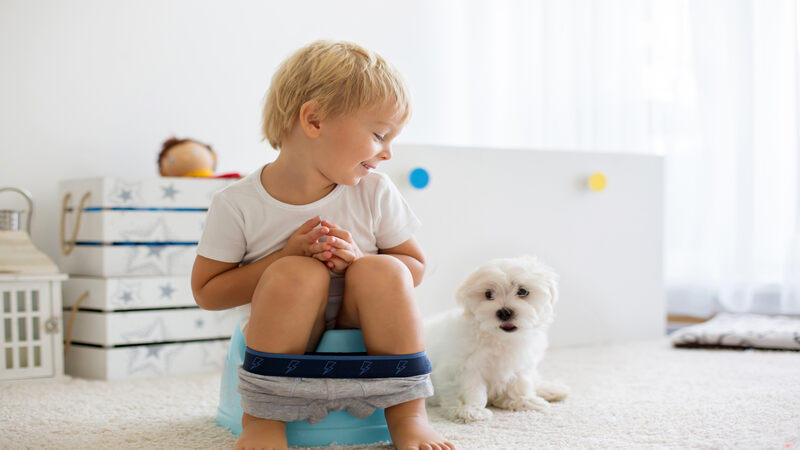
As your little one grows up, you might miss his baby talk, unsure steads, and mischief. But one thing you will absolutely not miss is cleaning his poop. The experience can be so unpleasant that most of us want our toddlers to be potty trained as early as possible. But potty training for boys is not that easy.
If you have a boy, then your road ahead in potty training might be relatively more difficult than mommies with daughters. Reports show girls to be faster learners than boys in terms of potty training (1). But there is nothing to worry about if you have a first-born boy! Give time, try consistently, and follow these tips for potty training for boys. Soon you can get him to the bathroom.
10 Successful Potty Training Tips For Boys
Parents try a lot of ways to potty train their toddlers. Some prefer training them as early as possible, while some want to go with the flow. While some try positive reinforcement such as rewards, others use negative reinforcement to discourage their toddler from using the diaper. So if you are confused about what methods of potty training will best suit your boy then here are some tips for you!
1. Time it Right
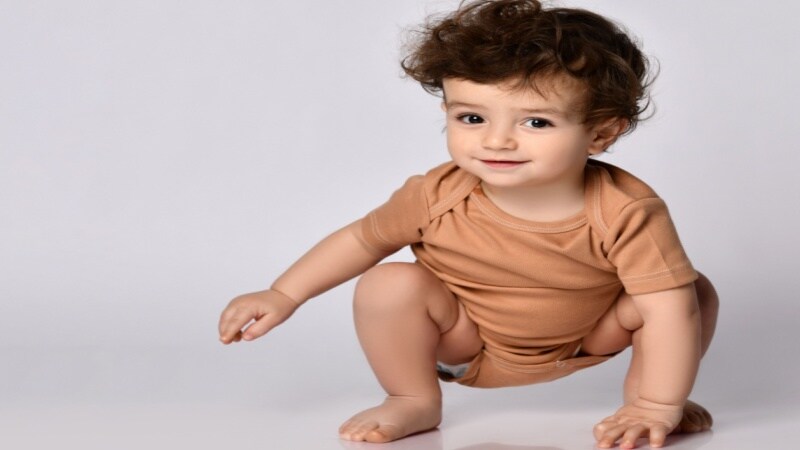
The most important aspect of potty training is timing. It is best to start potty training for boys between 18 to 30 months (2). Your son might not be physically capable of holding the pee before. A delayed start on the other hand can cause regression if your boy gets clingy to the diaper. So start it when he is physically and emotionally ready.
2. Show by Example
Kids have an inward tendency to imitate and learn the behaviors of others around them (3). Therefore, show your son how to pee in the toilet! Show him how his daddy stands to pee. It can be difficult to teach the ‘stand-to-pee-sit-to-poop’ concept at the beginning. If he is more comfortable sitting down and peeing in the initial days, let him. He will slowly learn the standing tactic.
3. Buy The Right Potty
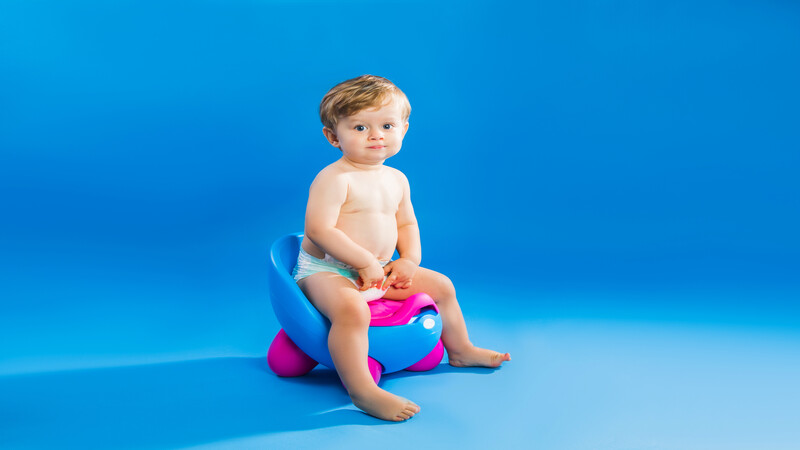
Buying the right potty for boys is important as they aim quite far while peeing. So it is a good idea to invest in a potty made by keeping this in mind. You can purchase a potty seat with a urine guard for boys to escape the hassle of cleaning urine splashes. But make sure that the urine guard is flexible and removable as they often tend to scrape the penis upon negligent use (4). You could take your son shopping so that he can choose a potty with designs that he likes.
4. Make Sure Your Boy is Comfortable
For the success of your potty training lessons, you need to get him comfortable sitting on the potty first. Try to familiarize him with the potty. Put him on it for some time every day. Once he starts perceiving it as a ‘happy’ place to be, then you can slowly urge him to pee in it.
5. Make a Routine
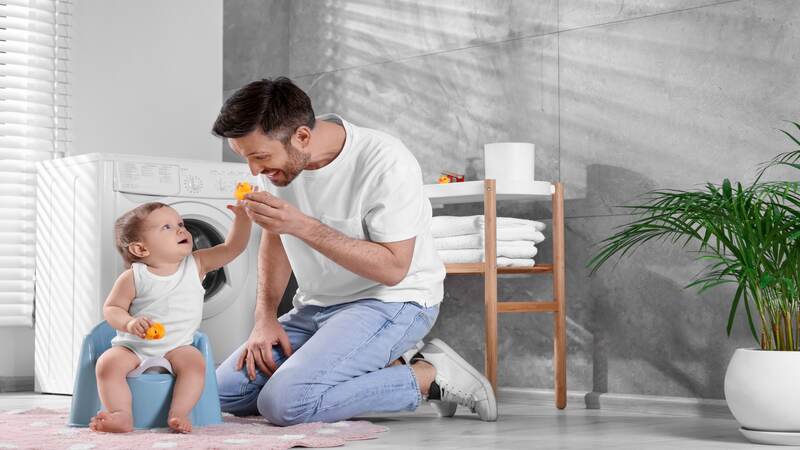
After timing, routine is the second most important thing in potty training. First, start with nappy-free days. Take him to the toilet every 30 minutes. Ask him to pee there. Once he gets used to peeing in the toilet, the frequency of wetting his underwear will reduce. You will notice that your boy is either pointing towards the toilet or going there all alone to do the job.
6. Be Consistent
Another important thing to note is consistency. Once you start potty training, do not switch him back to diapers for any reason. Certain situations can lure you to use a diaper such as traveling, a busy day or a family function. However, these shifts in regularity will unnecessarily delay the potty training process.
7. Use Songs And Storybooks
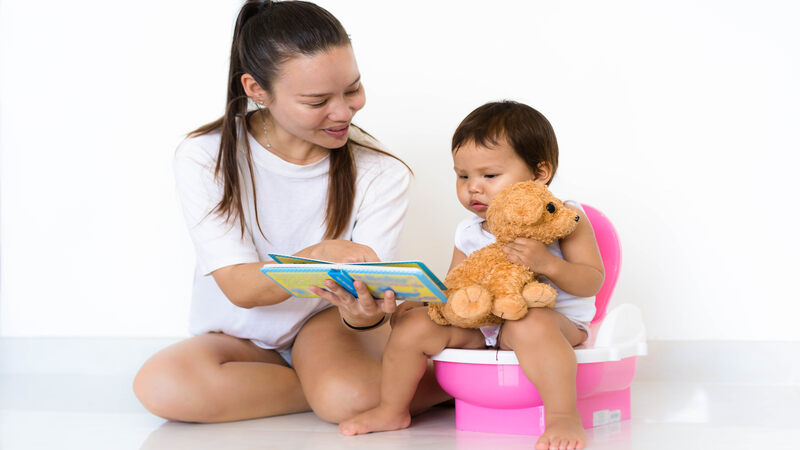
There are lots of funny potty training books available online that you can read to him. You can search for songs and poems dedicated to this special job. However, remember to use them in your free time, not when your boy is sitting on the potty to avoid distractions. You can also make a personalized potty training song for your boy. This can work like magic as kids pay more attention when music and melodies are involved, making it more fun for them (5).
8. Give Him Some Naked Time
Give your boy some naked time during the day. Let them realize the immediate wetness when they pee. This will quicken the process of potty training for boys. Make sure to put the potty within his reach so that he can use it instinctively. But mommy please be ready to clean up the mess if he does not do that.
9. Reward And Appreciate
Always insist on positive reinforcement like rewards, praises and appreciation to encourage positive habits in children (6). Every time he does it right, reward him. Make it very clear that you think he is a big boy now and potty training is a huge step towards being ‘big’.
10. Use Target Practice
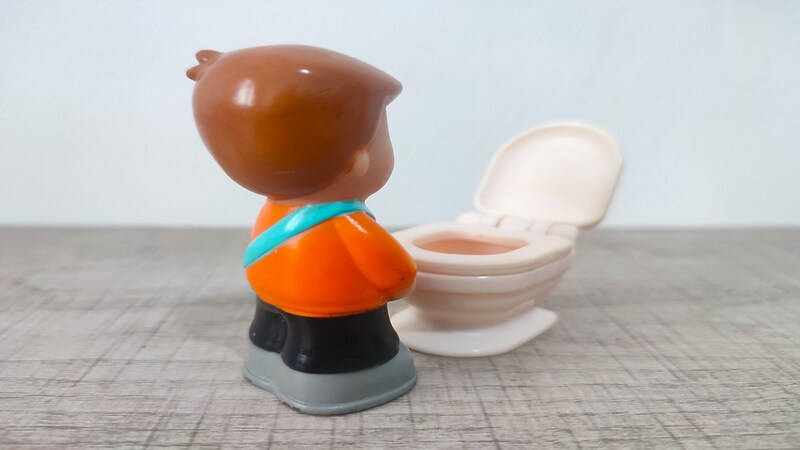
Target practice is an added lesson while you are toilet-training for boys. You will have to gradually insist your boy to stand and pee with the right aim. You can throw small pieces of toilet paper inside the commode and tell your son to aim there.
11. Be Accident-ready
Initially, there will be many accidents, wet nappies, wet floors, wet sofas, and whatnot! Brace yourself for this. Do not punish or scold him for accidentally wetting himself. Be patient. Eventually, your boy will understand and get used to the whole concept.
12. Progress to Night-time Training
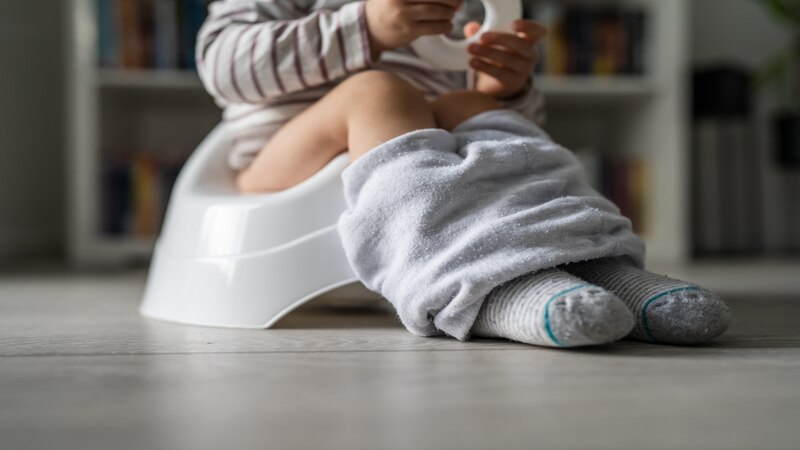
Once he starts having totally dry days, then you can graduate to nighttime training as well. Diaper-free nights are just a little effort away! Remember to limit his water intake at night so that he won’t feel the urge to pee much during his sleep. Protect your bed with water-absorbent sheets. Also, be prepared as night-time potty training takes longer to implement.
Follow these tips and give your boy some time. He will gradually get used to the shift from diapers to underwear. And in one fine day, you will see no wet nappies in your way.
Why Should You Not Push Potty Training?
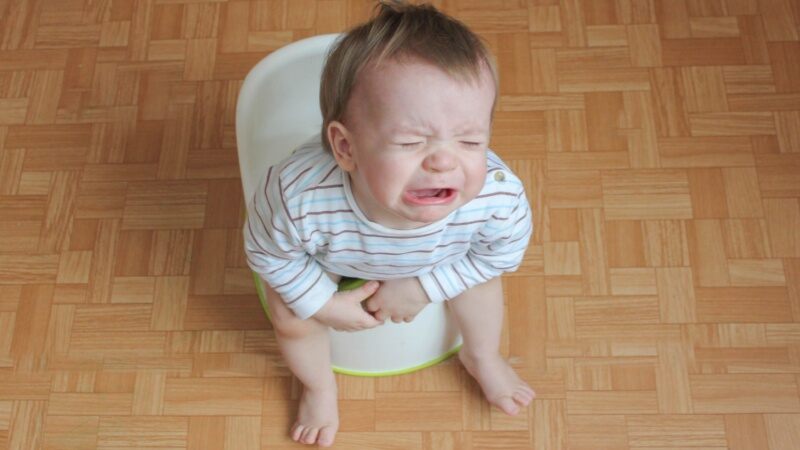
Timing is exceptionally crucial for potty training a child – as getting to it too early or too late can make potty training a frustrating journey. Though it is tempting for the parents to start the training as early as possible, early training can actually delay the process. Moreover, a study has claimed that kids who are toilet trained before the age of 18 months are more likely to suffer from constipation due to dysfunctional voiding (7).
On the other hand, anxiety, and the withholding tendency in case of delayed potty training can also cause constipation (8). Proper bladder control in children comes with physical and brain development (9). Your boy will give you signs when he is ready to be potty trained. Just observe and go with the flow.
So, potty training for boys is not that complicated if you know when to start and how to start. Do not just instruct but actively participate with your boy in the learning of this crucial life skill. Get the necessities like a potty seat with a urine guard, potty training books and poems at hand. And most importantly keep patience.
FAQ’s
1. What is The Average Age For a Boy to be Potty Trained?
The ideal time to begin potty training is between 18 to 24 months. However, boys tend to be 2 to 3 months behind girls in terms of verbal expression of their needs. So you can hold for a month or two to start.
2. Is 3 Too Late to Potty Train?
If your 3-year-old is still not potty trained do not panic. It is still not too late. You can take the assistance of the preschool teachers or daycare helpers to instill this habit in your kid. They will soon learn by watching other kids do it.
3. What is The Fastest Way to Potty Train a Boy?
The 3-day potty training method is the fastest way to potty train your boy. You will just have to let your boy go completely diaper-free or even naked for 3 days. He will soon feel the necessity to go to the toilet upon feeling the wetness.
4. When Can Boys Learn to go to The Potty Standing up?
Boys can learn to stand and pee after they have successfully potty trained. Initially, they may sit and do the poop and pee at the same time. But after a few demonstrations and observations, they will soon learn that they can stand and pee.
References
- Lang ME. Among healthy children, what toilet-training strategy is most effective and prevents fewer adverse events (stool withholding and dysfunctional voiding)?: Part B: Clinical commentary. Paediatr Child Health. 2008 Mar;13(3):203-4. doi: 10.1093/pch/13.3.203. PMID: 19252701; PMCID: PMC2529421. – https://www.ncbi.nlm.nih.gov/pmc/articles/PMC2529421/
- DREW C. BAIRD, MD, MICHAEL BYBEL, DO, AND ADAM W. KOWALSKI, MD, Am Fam Physician. 2019;100(8):468-474 – https://www.aafp.org/pubs/afp/issues/2019/1015/p468.html
- Main, P (2022, October 18). Vygotsky’s Theory. Retrieved from https://www.structural-learning.com/post/vygotskys-theory – https://www.structural-learning.com/post/vygotskys-theory
- Gwen Dewar, Ph.D., all rights reserved – https://parentingscience.com/potty-training-problems-prevention/
- Brolly Sheets – https://www.brollysheets.com.au/blogs/day-training/using-music-to-motivate-your-child-to-use-the-toilet
- Henry Ford Health Staff, Posted on March 25, 2021 – https://www.henryford.com/blog/2021/03/positive-reinforcement
- Hodges SJ, Richards KA, Gorbachinsky I, Krane LS. The association of age of toilet training and dysfunctional voiding. Res Rep Urol. 2014 Oct 3;6:127-30. doi: 10.2147/RRU.S66839. PMID: 25328866; PMCID: PMC4199658. – https://www.ncbi.nlm.nih.gov/pmc/articles/PMC4199658/
- Gibas-Dorna M, Piątek J. Functional constipation in children – evaluation and management. Prz Gastroenterol. 2014;9(4):194-9. doi: 10.5114/pg.2014.45099. Epub 2014 Sep 16. PMID: 25276249; PMCID: PMC4178044. – https://www.ncbi.nlm.nih.gov/pmc/articles/PMC4178044/
- Johns Hopkins Medicine – https://www.hopkinsmedicine.org/health/conditions-and-diseases/urinary-incontinence/urinary-incontinence-in-children

